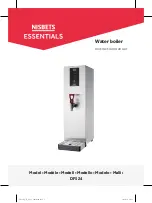
Part number 550-143-010/1021
48
GV90+
series
2
gas-fired water boiler – boiler manual
Vent and air piping and boiler connections
DIRECT EXHAUST & DIRECT VENT
Follow termination
instructions
Read and follow all instructions for the termina-
tion type used before proceeding with this page.
Installing vent and air piping
1. Work from the boiler to vent or air termina-
tion. Do not exceed the lengths given in the
previous pages for either the air or vent piping.
a. Provide polypropylene or stainless pipe to
PVC adapters obtained from the stainless
pipe manufacturer for connections at the
boiler and at terminations, when required.
2. See Figure 59 for attaching vent (and air) pipes
at the boiler.
3. Cut pipe to required lengths.
4. Deburr inside and outside of pipe ends.
5. Chamfer outside of each pipe end to ensure
even cement distribution when joining.
6. Clean all pipe ends and fittings. Dry thor-
oughly.
7. Dry assemble entire vent or air piping to ensure
proper fit before assembling any joint.
8. For each joint:
a. Handle fittings and pipes carefully to pre-
vent contamination of surfaces.
b. Apply primer liberally to both joint sur-
faces — pipe end and fitting socket.
c. While primer is still damp, lightly apply
approved cement to both surfaces in a
uniform coating.
d. Apply a second coat to both surfaces.
Avoid using too much cement on sockets
to prevent cement buildup inside.
e. With cement still wet, insert pipe into
fitting, twisting ¼ turn. Make sure pipe is
fully inserted.
f. Wipe excess cement from joint. Check
joint to be sure a smooth bead of cement
shows around the entire joint.
9. Maintain minimum clearance of
3/16
inch
between vent pipe and any combustible wall
or material.
10. Seal wall or floor penetration openings follow-
ing local code requirements.
DIRECT EXHAUST ONLY
DIRECT EXHAUST installations
— air inlet opening protection
:
Obtain a bird screen (sized for air
inlet fitting) from Weil-McLain.
Insert the bird screen into the air
inlet fitting to prevent foreign objects
from entering the opening.
Figure 59
Boiler vent and air connections
AL29-4C vent pipe — If using AL29-4C stainless vent pipe, you
must install an AL29-4C stainless vent starter at the boiler vent
connection (and at the termination if using the Weil-McLain plate
or the concentric termination). Use only the starter made by the
vent pipe manufacturer. See Replacement parts section for avail-
able AL29-4C stainless vent starters.
For polypropylene applications, comply with any additional
requirements in the vent system manufacturer’s instructions.
Provide 3” PVC-to-PP transition pieces at the boiler vent and air
connections. PP adapter must have smooth, straight section of
pipe to insert in to the boiler vent and air connections and must
fit and seal tightly. PP adapters with their own seal which would
interfere with the internal seal of the boiler vent or air connec-
tions must not be used. Refer to page 91, in this manual for a
list of compliant adapters. Install a locking collar at every joint.
1. PVC/ABS pipe — Clean and deburr inside and outside of other both ends
of air and vent pipes. Chamfer boiler end of vent pipe for ease of insertion.
The vent pipe end must be smooth and chamfered to prevent pos-
sible damage to sealing gasket in vent pipe adapter.
2. Inspect vent adapter and air inlet fitting (above) — verify no obstructions
or foreign objects inside.
3. Vent pipe
• Loosen vent adapter clamp screw.
• Measure 3½ inches from boiler end of vent pipe and make a mark with
felt-tip pen.
• Apply small amount of silicon grease to boiler end of vent pipe to ease
insertion.
• Insert vent pipe into adapter to depth of felt tip pen mark.
• Secure vent pipe by tightening the adapter clamp securely. Do not over-
tighten. The seal is accomplished with the internal gasket. The clamp is
only to hold the pipe in place.
Do not apply excessive force or bend the vent adapter or vent
pipe when inserting. The adapter or seal could be damaged.
4. Air pipe
• Clean the outer surface of the boiler end of the air pipe.
• Apply silicon sealant (Dow Corning 732TM or equivalent) to the outside
end of the air pipe and to the inside of the air inlet fitting.
• Insert the air pipe into the air inlet fitting and give a 1/4 turn to ensure
coverage. Support until the sealant has dried.
















































